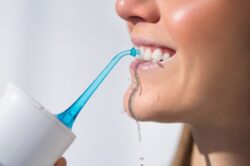Brushing your teeth and flossing are crucial actions that make up your oral hygiene routine. If you do not practice this care properly, plaque and other dangerous residues will cling to your teeth and put your dental structure at risk of deterioration. This could mean you form cavities, gum disease, and other oral health problems.
Traditional string floss will remove excess plaque between teeth effectively. But you can see more precise and comprehensive results when you use a water flosser. This oral hygiene tool generates a stream of irrigated water that you aim at your teeth to wash away plaque build-up.

How to Use a Water Flosser
Using your water flosser correctly will maximize preventative dental care and help you better fight dental concerns. Read on to find advice from your dentist on how to utilize this appliance to clean your smile.
Select Settings That Suit Your Smile
A water flosser may come with several setting options that you can adjust to the specific needs of your smile. For instance, you may swap out the tip of the flossing device where the water comes out. You can choose the standard tip, the one designed for navigating around orthodontics or other appliances, or the tip made for thorough cleaning of the gum pockets.
The water flosser can also feature different pressure settings which control the power of the water emerging from the tip. Begin with a low-pressure setting until you know how the flosser feels in your mouth. Then you can adjust the pressure to your comfort level.
Maneuver Your Water Flosser with Purpose
Proper usage of your water flosser will mean using the hygienic tool with purposeful movements. Simply spraying water into your mouth without direction will not remove plaque where needed.
Consider using your water flosser in front of a mirror so that you can see where to aim the water to properly clean your smile. Start with the molars at the back of the mouth and move your way forward. Navigate the stream of water to clean all edges of your teeth, including near the gumline.
Remember to clean the front and back of the teeth as well as between them. This will clear away stubborn plaque that your toothbrush cannot always reach. Use your flosser in conjunction with your teeth-brushing regimen to maximize oral hygiene benefits. This tool is not a replacement for your usual regimen, including attending routine dental cleanings.
A water flosser might make a mess if you are not careful. When using the flosser, lean forward over a sink. Keep the tip of the device close to the inside of your lips.
Then allow the water to flow over your lips and into the sink as you floss. This prevents water from spraying and spilling into puddles around your bathroom. You might also benefit from using a cordless water flosser that you can use in the shower. Call your dentist with any questions about the usage and benefits associated with this device.
